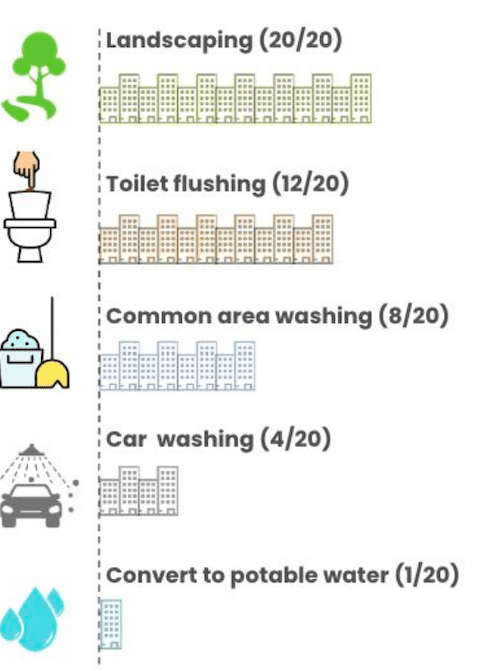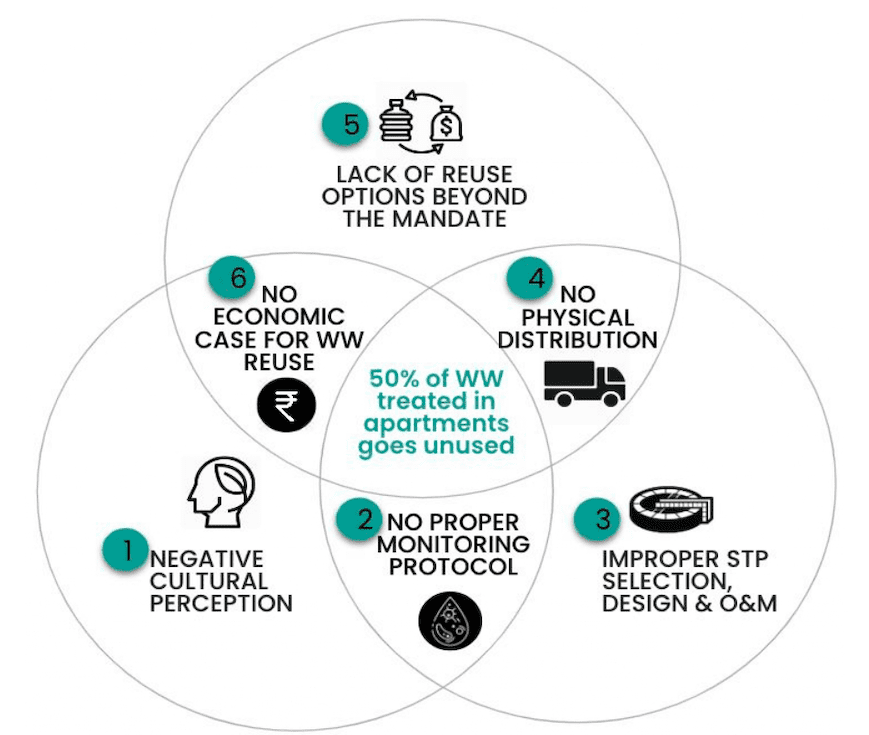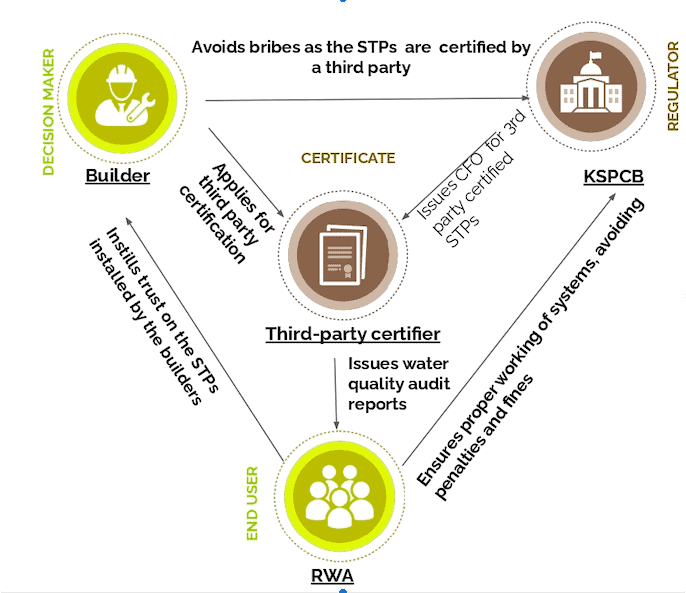Do you live in an apartment with its own sewage treatment plant (STP)? Do you know how much of the treated water is reused and how much ends up clogging the city’s stormwater drains? Despite laws in place in Bengaluru that mandate the setting up of decentralised plants and ‘zero discharge’, i.e. for all the treated water to be used up within the apartment fence, turns out reuse levels remain alarmingly low.
The city now has over 3,000 decentralised STPs, which treat 615 million litres of sewage every day. Centralised STPs generate another 650 MLD of treated water. But the bulk of this – around 720 million litres of wastewater goes unused. This is concerning because of the potential that wastewater holds in building climate-resilient cities. By replacing freshwater for a range of non-potable uses, wastewater reuse can significantly reduce the pressure on depleting aquifers and address water scarcity.
To understand why such an obvious opportunity was being squandered, the Centre for Social and Environmental Innovation (CSEI) at ATREE in Bengaluru conducted a study that involved interviews with a wide range of stakeholders including apartment residents, STP operators, government officials and builders. Of the 20 apartments we surveyed, we found that wastewater was currently being used for five purposes (image below) – landscaping, toilet flushing, cleaning common areas and cars, and, in one case, converted to potable water. But this needs to improve.

Read more: How to fix problems with apartment STPs
We identified six barriers and outlined possible ways to address them.

The Yuck Factor: Negative cultural perception of wastewater
Surveys showed that residents preferred reusing greywater, which is generated from sinks, showers and laundry, over blackwater, which is generated from toilets even if the STP has the capacity to treat the blackwater to a high quality.
What was interesting though was that separation alone wasn’t enough to boost reuse. This was revealed when we visited a site where blackwater and greywater was being treated separately – residents were still not reusing the treated greywater for anything other than toilet flushing or landscaping.
What’s more, we found garbage such as shampoo sachets and plastic bottle caps being discarded into shower drains (image below), which is where the bulk of the grey water comes from, clearly indicating that residents did not view this water as a potential source of freshwater. There are fixes to these trust issues such as establishing better STP technology, better protocols, and carrying out awareness-building programmes to name a few.

No proper monitoring and compliance with water quality standards
The interviews revealed that wastewater testing is infrequent. The main reason for this is the high cost of water testing and the tendency for some officials to seek bribes in exchange for penalties being waived off. Reports by the Karnataka Pollution Control Board revealed that almost 80% of decentralised STPs are not adhering to the minimum discharge standards.
We asked RWAs about the monitoring frequency of treated wastewater and compared them to the guidelines, which require apartments to test their wastewater at a National Accreditation Board for Testing and Calibration Laboratories (NABL) every two months. We found that only three out of 20 RWAs were monitoring their STP output water quality regularly. The frequency of testing across the range of apartments varies and is often less frequent than required.
However, this goes under the radar. The majority of STP operators and RWAs interviewed mentioned that the site visits rarely push for compliance. One way to avoid this, we found, based on our review of best practices in other countries, was to distinguish between the makers and enforcers of regulations.
Read more: “Fining apartment owners for faulty sewage treatment plants is unjust”
Improper STP selection and design
Improper STP design was identified as one of the main causes of failure of STPs, according to a study by SANDEC (Department of Sanitation, Water and Solid Waste for Development at the Swiss Federal Institute of Aquatic Science and Technology).
One way to ensure better STP designs is to ensure that future homeowners’ interests are taken into account. This way, STPs that are easy to operate and have a lower OpEx are more likely to be opted for. The problem is that homeowners do not come into the picture till after the STP has already been built. Educating potential home buyers about the key attributes of STP design is critical. The Bengaluru Apartments Federation (BAF) and Confederation of Real Estate Developers’ Associations of India (CREDAI) can be platforms to inform and guide end-users.
Moreover, the process of selecting STP design is inherently biased. We found that builders rely on experts, i.e. MEP (mechanical, electrical, plumbing) consultants, to help decide which STP to select. These consultants tend to choose technology or manufacturers/sellers that they are familiar with. The absence of standardisation in this sector fosters such inconsistencies. Therefore, third-party certification and service contract models are necessary to enable regular audits and accountability, and thus smooth functioning of STPs. It also builds trust among residents.

Tanker networks are hesitant to transport wastewater
Tankers are a key part of this equation but they are reluctant because:
- Lack of sustained demand for treated wastewater,
- Fear of losing their main business of conveying fresh water because of the ‘yuck factor’ associated with treated wastewater,
- Presence of a tanker mafia.
One way to address the lack of sustained demand is by creating a digital platform that helps sellers and buyers find each other.
Simple measures such as colour coding the tankers to differentiate those carrying treated wastewater and an EPI coating inside the tanker to prevent chemical reactions are ways in which residents can be reassured that the same tanker is not carrying both treated wastewater and freshwater.
Additionally, factors such as the number of transactions per day, travel distance and the time taken for loading and unloading will play a crucial role in making these transactions economically viable. Interviews with tanker operators revealed that treated wastewater transactions would be viable if the tanker does 7-8 trips per day within a 5-kilometre radius between the source of wastewater and the destination (be it a park or a construction site).
No viable reuse options beyond those listed in the mandate
The KSPCB’s Zero Liquid Discharge mandate requires apartments to reuse all their treated wastewater. It is impractical for apartments to comply with this mandate of 100% reuse given that older apartments without dual plumbing use treated wastewater only for landscaping, and apartments do not water their landscapes during the monsoon.
Apart from the five uses, we mentioned at the beginning, It is necessary to identify safe, economical and culturally-appropriate reuse options if residents are to reuse 100% of their treated wastewater. A necessary precondition for this is robust water quality testing services and monitoring regime.
For example, reusing excess treated wastewater for aquifer recharge is a potential option as 100% of the RWAs (residents welfare associations) we spoke to consented to this. Because of the risk of groundwater contamination, it is crucial that water is treated to a high quality.
Another option is to identify reuse options based on the quality of water produced. We found that countries like Israel that were not treating wastewater to potable water standards were still able to achieve almost 100% reuse through measures like the multi-barrier approach, i.e. assigning a standard quality of treated water for various non-potable uses.
There are insufficient financial incentives for reusing wastewater
Apartment communities in Bengaluru play a vital role in wastewater management, but the only incentive for apartments with decentralised STPs is that their sewage and sanitation charges of a minimum of Rs. 100 is waived off. However, the average cost of STP maintenance exceeds the potential savings from the waiver of sewerage and sanitation charges by nearly four times.
Apartments that rely on expensive tanker water have a clear economic incentive to reuse treated wastewater and reduce tanker costs. However, those apartments with access to piped water networks have no financial incentive to reuse wastewater as the price of freshwater is very low. This is likely to become a bigger problem as BWSSB supply extends to new areas.
In areas receiving piped supply, lower tariffs for apartments that reuse all their wastewater will ensure wastewater is treated. Additionally, creating a market for selling excess treated wastewater could make it valuable, and thus incentivise residents to fund the proper maintenance of their STPs.
Under the Cities and Towns initiative of the CSEI, we are working on three campaigns – Grey to Green (wastewater to maintain green spaces), Grey to Yellow (wastewater for construction and industrial purposes) and Grey to Blue (using wastewater for aquifer recharge) as ways forward to reuse the excess treated wastewater in Bengaluru. We are supporting the KSPCB with the Grey to Green campaign, which aims to help apartments channel their excess treated wastewater for greening public parks and medians.
All of the 720 MLD of excess treated wastewater could be utilised if these campaigns were scaled across Bengaluru. And as a result, almost a third of the total daily freshwater demand would be replaced with treated wastewater, reducing the pressure on our depleting aquifers and the Cauvery.
